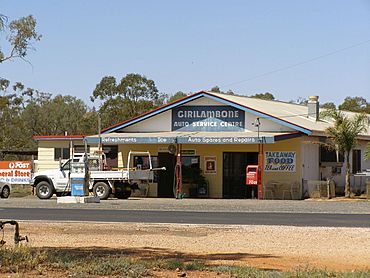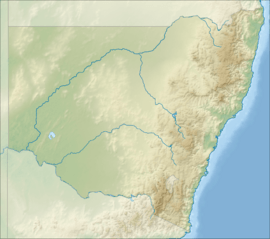Girilambone, New South Wales facts for kids
Quick facts for kids GirilamboneNew South Wales |
|
|---|---|

Petrol station, 2007
|
|
| Population | 107 (2016 census) |
| Postcode(s) | 2831 |
| Elevation | 195 m (640 ft) |
| Location | |
| LGA(s) | Bogan Shire |
| Region | Orana (New South Wales) |
| County | Canbelego |
| State electorate(s) | Barwon |
| Federal Division(s) | Parkes |
Girilambone is a small village in western New South Wales, Australia. It is located north of Nyngan and about 610 kilometers northwest of Sydney. The name Girilambone also refers to the surrounding area for postal and statistical reasons. In 2016, the village and its nearby areas had a population of only 107 people. By 2021, this number had dropped to 86. This village was originally important because of copper mining.
Contents
Discovering Girilambone's Past
Aboriginal Heritage and the Name
The land around Girilambone is the traditional home of the Wangaaypuwan people. They are a dialect group of the Ngiyampaa nation.
The name "Girilambone" comes from a local Aboriginal language. It means 'place of many stars' or 'place of falling stars'. This name is linked to a Dreamtime story of the local people. This story might be connected to an event in space. A large meteorite weighing 32 kilograms was found 70 kilometers southwest of Girilambone in 1909.
In 1907, no Aboriginal people were officially recorded as living in Girilambone. However, the 2021 census showed that some people living there had Aboriginal ancestry.
The Story of Settlers and Mining
People first noticed copper ore in the Girilambone area in 1875. Mining began on a small scale at the Girilambone Copper Mine in early 1880. This mine was about 3 kilometers west of the current village. In 1881, a special furnace called a reverberatory smelter was built there.
Girilambone started as a private mining town. In late 1880, a 100-acre piece of land was surveyed. This land was east of the mine and next to where the railway line was planned. The first school in the area opened here in 1882.
The Arrival of the Railway
The Main Western railway line reached Girilambone in 1884. A new government village was then planned on the eastern side of the railway line. The railway station opened in 1884 with the name 'Giralambone'. Its name was changed to 'Girilambone' in 1889.
For many years, there were two Girilambone settlements. There was the original private mining town, called Girilambone Mine. Then there was the newer government village of Girilambone. The government village slowly became the main center. Some businesses moved to the new village, while others moved to Nyngan. Today, almost nothing remains of the first Girilambone.
Growth and Changes
By 1891, Girilambone had 161 people living in 34 homes. In 1897, a new public school opened in the government village. The older school closed in 1904. A new post office opened in the government village in 1894. The older post office closed in 1919. A new police station and lock-up opened in 1899.
In 1895, the Girilambone Copper Mine was sold because copper prices were low. A new company, the Girilambone Copper Mining Co., was formed in 1896. This began the main period of copper production, which lasted until 1901. Copper prices had increased during this time. On January 11, 1901, strong winds damaged many buildings at the mine and in the village. Some were completely destroyed.
After April 1901, copper prices dropped. By the end of 1901, mining was no longer profitable. The Girilambone Copper Mining Co. closed in 1902. A new company, Girilambone Mining Co., took over. Mining restarted and continued until around 1910.
Churches and Community Life
On July 16, 1898, a Catholic church was opened and blessed. It is located on the eastern corner of Sirius and Myall Streets. This church is now closed but the building is still there.
On January 17, 1913, a Union Church was opened. This church was meant for all Christian groups to use. About 300 people attended the opening.
In 1915, Girilambone's population was estimated at 400 people. By 1931, it was 317. The 1933 census showed 156 people in the village and 136 in the surrounding area.
St Paul's Anglican Church in Myall Street held its first service on August 30, 1925. The church building was originally a shop from Cobar that was moved to Girilambone. This church is also now closed and is privately owned.
Modern Times
The police station in Girilambone closed in 1975. The railway station closed in 1986.
The village has two cemeteries. One was established in 1901 on Arcturus Street. An older one, the Old Girilambone Cemetery, is on Sydney Road. This older cemetery is closer to the original mining settlement and has not been used for many years.
The old Girilambone Copper Mine deposit was part of a larger deposit called Murrawombie. This deposit was mined again using open pit methods from 1993 to 2002. In 2008, a new underground mine was opened to get deeper copper ores. However, mining stopped soon after due to economic conditions. Mining operations started again in late 2015. Even though mining has restarted, it has not directly helped Girilambone much.
In 2019, the New South Wales government announced plans to fix the old railway station building. They want to turn it into a visitor center with a museum and an Indigenous art gallery. Work on restoring and renovating the building was well underway in September 2022.
Images for kids








